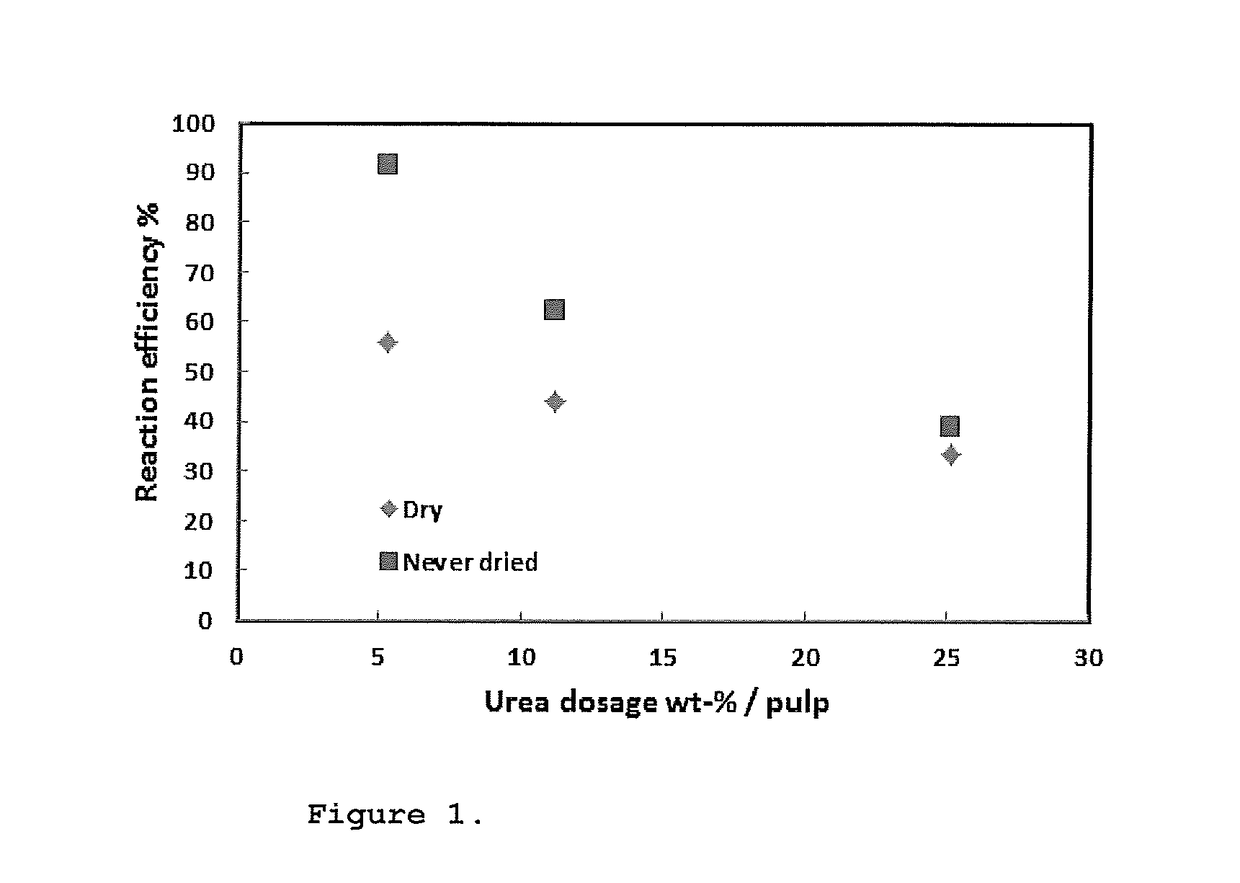Method for making cellulose carbamate
a technology of cellulose carbamate and cellulose, which is applied in the direction of vegetable material, fibre chemical treatment, fibre treatment, etc., can solve the problems of not being commercialized, the fibre properties do not match all applications, and the conversion of cellulose to higher-end products
- Summary
- Abstract
- Description
- Claims
- Application Information
AI Technical Summary
Benefits of technology
Problems solved by technology
Method used
Image
Examples
example 1
[0070]The differences in the carbamate process between dried and never dried pulp was examined. The used never dried pulp was taken directly from the pulp mill at ˜8% consistency and centrifuged to solid content of ˜35%. The dried samples were treated in the following way: the dry cellulose sheets were suspended with water over night and on the following day disintegrated with a cellulose pulper and centrifuged. The solid content of the so-treated pulp was 41%.
[0071]The pulp (375 g abs dry) was added to the reactor. Urea and hydrogen peroxide were added to the mixture, carefully one after another at the same time as mixing of the cellulose in the Lödige DVT-7 mechanical fluid bed type reactor occurred. The mixing lasted ca. 60 min. The solid content of the mixture was adjusted to 25% by adding the extra RO-water (purified with standard method using reverse osmosis) with urea and hydrogen peroxide. This was followed by vacuum drying at a temperature of 50-60° C. under mixing. The mix...
example 2
[0081]Two different samples were prepared. One comprising dried pulp 2a) and one comprising never dried pulp 2b).
[0082]2a) The dried pulp sample was mixed with solid urea (particle size ˜5 mm) and small amount of aqueous peroxide in a mechanical fluid bed batch mixer (Forberg-mixer) in a way that the consistency before the following mechanical work in a compounding step was ca. 70 wt-%. The compounding was done in the same was as described in FI112795B. After the compounding step, the mixture was put in an oven (140° C.) for 4 hours in order for the carbamate reaction to occur.
[0083]2b) The never dried pulp had a consistency of 20 wt % when urea was slowly poured as aqueous solution during mixing to a Druvatherm mixer and further mixed with the pulp. The mixture was dried under mild conditions (temperature <80° C.) to a consistency of ca. 90 wt-%. A small amount of aqueous peroxide was thereafter added to the mixture similar to the procedure in 2a) in the same mixer so that the cons...
PUM
| Property | Measurement | Unit |
|---|---|---|
| temperature | aaaaa | aaaaa |
| temperature | aaaaa | aaaaa |
| temperature | aaaaa | aaaaa |
Abstract
Description
Claims
Application Information
 Login to View More
Login to View More - R&D
- Intellectual Property
- Life Sciences
- Materials
- Tech Scout
- Unparalleled Data Quality
- Higher Quality Content
- 60% Fewer Hallucinations
Browse by: Latest US Patents, China's latest patents, Technical Efficacy Thesaurus, Application Domain, Technology Topic, Popular Technical Reports.
© 2025 PatSnap. All rights reserved.Legal|Privacy policy|Modern Slavery Act Transparency Statement|Sitemap|About US| Contact US: help@patsnap.com


